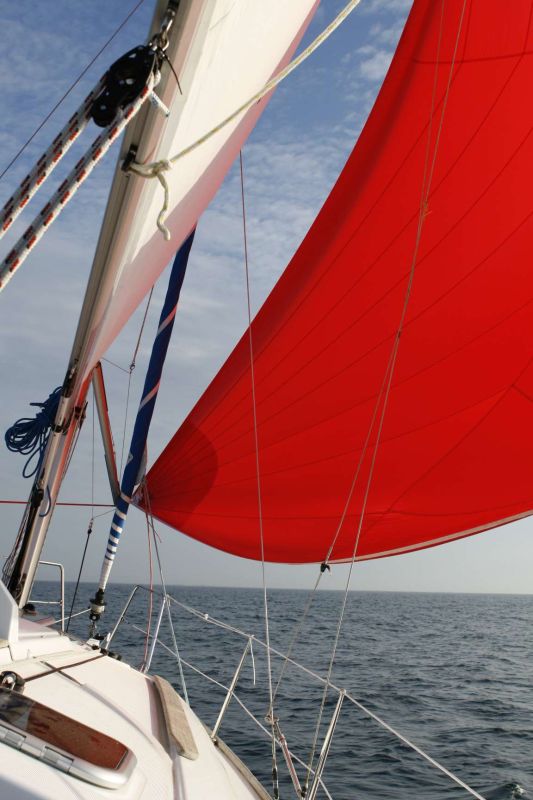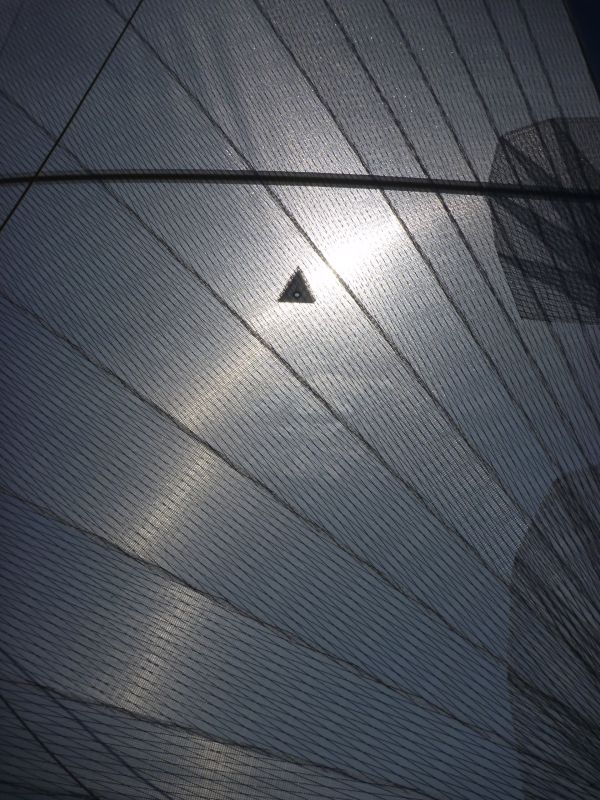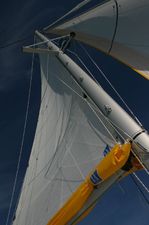The engine of the sailboat!
The Mainsail
The current trend seems to be to trim the mainsail with battens. On multihulls the mainsails have slats to make hold the horizontal width of the sail and are distributed from the masthead to the boom. This permits better sail control, especially up high and offers more power by increasing the roach. In addition the sail flutter is minimized. The only drawback is that it must be mounted on runners (bearing if possible) for effortless hoisting and lowering; an accessory which may seriously damage the budget. For racing, helmsmen prefer the standard sail, it is lighter and allows more settings. For older sailing vessels, on which the backstay is often the roach, we may also choose a partially slatted mainsail (semi-battened.)
The Genoa
The roller furling Genoa has become a must on the majority of recreational vessels. However, one must not count on a furled Genoa holding in a storm. This sail provided for very strong winds, must be sized with a very flat form and have a surface adapted to the boat. Since it is not possible to adapt it on a roller (except for very specific models,) the solution, for sending, remains the releasable stay. This stay, indispensable if you envisage a long crossing, can be made with new textile materials.
La voile est un élément déterminant pour votre navigation et vos économies d’énergie. Selon vos besoins, AD vous propose des voiles adaptées à votre bateau après une prise de mesure exacte à bord. Voile de croisière ou de régate, taille, coupe, tissu, couleur, finitions… Profitez d’une nouvelle voile optimale pour votre bateau, et ce à prix AD !
The Spi
Symmetrical or asymmetrical? The symmetric spi is rigged with a pole. It thus manages more manoeuvres with fewer subtleties. This is why the asymmetric version, attached to the bow is often preferred by pleasure sailors. With a tail wind the asymmetric spi is masked by the mainsail and can hold in position, unlike the symmetric model which can switch to the wind, thanks to the pole. An intermediate solution is to install a pole and an asymmetric. This facilitates full downwind sailing. The gennaker? This acts as a king of balloon jib. It allows you to go upwind in light airs, when the jib is having trouble. The gennaker is often fitted to a drum, for easy storage.

Accessories
Think about protecting your sails during periods of inactivity: boom cover, lazy bag or Genoa sheath, permit sails to be left in position without worry. For downwind sails we think of a spinnaker sock, or a removable bowsprit to increase spi performance.
Fabrics used
The quality of the fabric depends on the characteristics of its components, the number of threads per square centimetre, the quality of weaving and finally, the resins applied. The strength of a fabric is assessed to its weight: the thicker the thread, the higher its strength (but more difficult to thread tightly.) The material most widely used on pleasure boats is Dacron (high density polyester) which comes in many variations, depending on the weight, quality of weaving, fibre, density and type of finish resin. There are also other materials such as Mylar ® (dimensionally stable polyester film) strong, very light but brittle, susceptible to bending and difficult to store, Kevlar ® (5 times stronger than polyester) and lighter, but very sensitive to UV and folding and Spectra ® resistant to stretching, bending, UV, stable and very light; this was, for a long time, the preserve of long distance sailors or racers but is now also used for recreation. To make sure a material is right for you contact your AD advisor.

How to order
You must specify your type of boat and mast, the year of construction, weight, the type of rigging, the diameter of stays, roller or headstay and the sail surface (dimensions of the hoist, edge and tack detail, as well as luff.) The zone and type of navigation, the average time of use of the boat. AD has a selection of Vega Voiles sails. All AD stores have a record of information that will be checked before any order to ensure the right sails for your requirements are provided.
When to replace them?
The price of a standard set of new sails represents about 8 to 15% of the value of a new boat. A traditional mainsail can last as long as ten years. Depending on use the recreational sailor may, however, change them every 5 years. When one decides to replace a sail there are 2 points to consider: the shape, as this determines performance and comfort. A distorted sail can become too powerful, it may cause drops in speed or make the tiller feel hard and uncomfortable. Only at sea, in a brisk wind will you be able to assess this accurately. Solidity, there is no need to go out to check the strength of a sail. A seam that begins to unravel, or worse, an early tear in the fabric ...A mainsail left on the boom, without protection, will spoil rapidly. Similarly, an unfurled Genoa with no UV protection will be spoiled by the sun in just 2 years. There are parts that could be ruined before the canvas (oxidation of eyelets, condition of reef supports, the clew, batten sheaths.) This does not condemn your sail but does enforce a rapid review.


